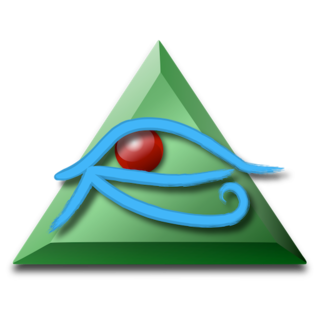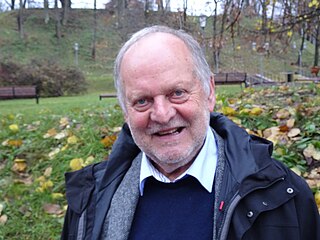Related Research Articles
In mathematics, computer science and economics, an optimization problem is the problem of finding the best solution from all feasible solutions.
The mode is the value that appears most often in a set of data values. If X is a discrete random variable, the mode is the value x at which the probability mass function takes its maximum value. In other words, it is the value that is most likely to be sampled.

OsiriX is an image processing application for Mac dedicated to DICOM images produced by equipment. OsiriX is complementary to existing viewers, in particular to nuclear medicine viewers. It can also read many other file formats: TIFF, JPEG, PDF, AVI, MPEG and QuickTime. It is fully compliant with the DICOM standard for image communication and image file formats. OsiriX is able to receive images transferred by DICOM communication protocol from any PACS or medical imaging modality.
Multimodal interaction provides the user with multiple modes of interacting with a system. A multimodal interface provides several distinct tools for input and output of data.
Multimodal may refer to:
SCXML stands for State Chart XML: State Machine Notation for Control Abstraction. It is an XML-based markup language that provides a generic state-machine-based execution environment based on Harel statecharts.
The Multimodal Interaction Activity is an initiative from W3C aiming to provide means to support Multimodal interaction scenarios on the Web.
A multimodal logic is a modal logic that has more than one primitive modal operator. They find substantial applications in theoretical computer science.
Social semiotics is a branch of the field of semiotics which investigates human signifying practices in specific social and cultural circumstances, and which tries to explain meaning-making as a social practice. Semiotics, as originally defined by Ferdinand de Saussure, is "the science of the life of signs in society". Social semiotics expands on Saussure's founding insights by exploring the implications of the fact that the "codes" of language and communication are formed by social processes. The crucial implication here is that meanings and semiotic systems are shaped by relations of power, and that as power shifts in society, our languages and other systems of socially accepted meanings can and do change.

Gunther Rolf Kress MBE was an Australian semiotician who was Chair of Semiotics and Education in the Department of Culture, Communication and Media within the Institute of Education of University College London.
Multimodal transport is the transportation of goods under a single contract, but performed with at least two different modes of transport; the carrier is liable for the entire carriage, even though it is performed by several different modes of transport. The carrier does not have to possess all the means of transport, and in practice usually does not; the carriage is often performed by sub-carriers. The carrier responsible for the entire carriage is referred to as a multimodal transport operator, or MTO.
In applied mathematics, multimodal optimization deals with optimization tasks that involve finding all or most of the multiple solutions of a problem, as opposed to a single best solution. Evolutionary multimodal optimization is a branch of evolutionary computation, which is closely related to machine learning. Wong provides a short survey, wherein the chapter of Shir and the book of Preuss cover the topic in more detail.

Dusner is a language spoken in the village of Dusner in the province of Papua, Indonesia. Dusner is highly endangered, and has been reported to have just three remaining speakers.
Multimodal Architecture and Interfaces is an open standard developed by the World Wide Web Consortium since 2005. It was published as a Recommendation of the W3C on October 25, 2012. The document is a technical report specifying a multimodal system architecture and its generic interfaces to facilitate integration and multimodal interaction management in a computer system. It has been developed by the W3C's Multimodal Interaction Working Group.

Ust-Luga Multimodal Complex is a project aimed at development of the portside area of about 3000 hectares located on the Soikinsky Peninsula by the Gulf of Finland in close proximity to the terminals of Ust-Luga Sea Merchant Port in Kingiseppsky District of Leningrad Oblast, Russia. The project developer is LLC "Multimodal complex Ust-Luga".
Multimedia translation, also sometimes referred to as Audiovisual translation, is a specialized branch of translation which deals with the transfer of multimodal and multimedial texts into another language and/or culture. and which implies the use of a multimedia electronic system in the translation or in the transmission process.
Multimodality is the application of multiple literacies within one medium. For example, understanding a televised weather forecast (medium) involves understanding spoken language, written language, weather specific language, geography, and symbols. Multiple literacies or "modes" contribute to an audience's understanding of a composition. Everything from the placement of images to the organization of the content to the method of delivery creates meaning. This is the result of a shift from isolated text being relied on as the primary source of communication, to the image being utilized more frequently in the digital age. Multimodality describes communication practices in terms of the textual, aural, linguistic, spatial, and visual resources used to compose messages.
Emotion recognition is the process of identifying human emotion. People vary widely in their accuracy at recognizing the emotions of others. Use of technology to help people with emotion recognition is a relatively nascent research area. Generally, the technology works best if it uses multiple modalities in context. To date, the most work has been conducted on automating the recognition of facial expressions from video, spoken expressions from audio, written expressions from text, and physiology as measured by wearables.
The accuracy paradox is the paradoxical finding that accuracy is not a good metric for predictive models when classifying in predictive analytics. This is because a simple model may have a high level of accuracy but be too crude to be useful. For example, if the incidence of category A is dominant, being found in 99% of cases, then predicting that every case is category A will have an accuracy of 99%. Precision and recall are better measures in such cases. The underlying issue is that there is a class imbalance between the positive class and the negative class. Prior probabilities for these classes need to be accounted for in error analysis. Precision and recall help, but precision too can be biased by very unbalanced class priors in the test sets.
Multimodal cancer therapy, often referred to simply as multimodal therapy or multimodal cancer care is an approach for treatment of cancer that combines of radiation and chemotherapy likes multiple therapeutic modalities. For example, in the case of mesotheliomas, treatments combine modalities such as surgery, chemotherapy, immunotherapy, and radiotherapy. Multimodal treatments can often have synergistic effects leading to better clinical outcomes.
References
- ↑ IBM article on multimodal technology, retrieved on October 25, 2005